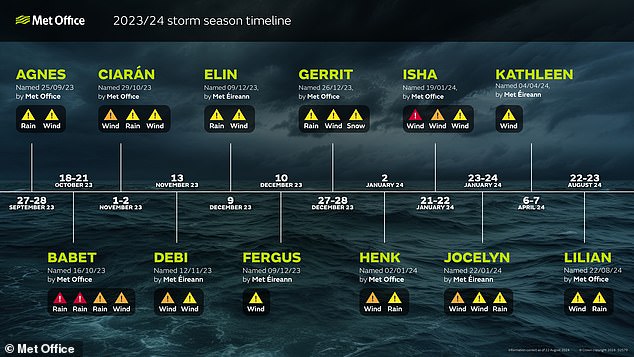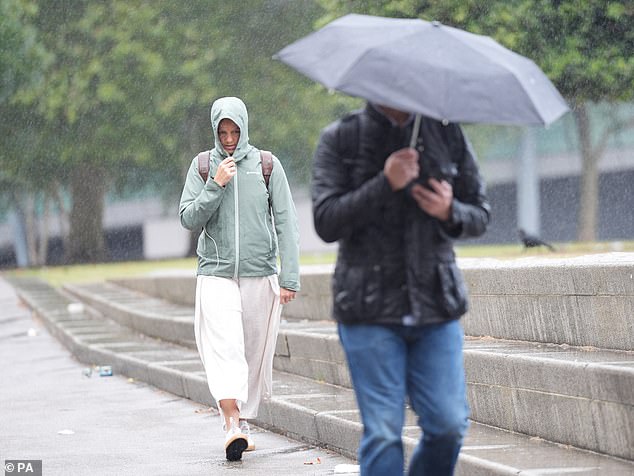Met Office publishes full list of UK storm names for 2024/2025. Do you share a name with one of them?
From Storm Agnes to Storm Lilian, several devastating storms have wreaked havoc across Britain over the past year.
In fact, the UK has had the highest number of named storms since the Met Office’s storm naming system was launched in 2015, with 12 named storms from 1 September 2023 to 31 August 2024.
The Met Office has now released the full list of storm names for 2024/2025.
“Naming storms makes it easier to communicate about extreme weather and provides clarity on when people could be affected by the weather,” explains Will Lang, the Met Office’s Head of Situational Awareness.
Do you have a name for one of the storms coming?
From Storm Agnes (pictured in County Waterford) to Storm Lilian, several devastating storms have wreaked havoc across Britain over the past year

Now the Met Office has released the full list of storm names for 2024/2025
The Met Office has been naming storms since 2015. The annual list runs from early September to late August the following year.
Storms are given a name when the Met Office determines they could have a ‘moderate’ or ‘major’ impact in the UK, Ireland or the Netherlands.
Although wind is the most important factor in naming a storm, the influence of rain or snow is also taken into account.
“Our top priority is to protect lives and property from extreme weather events and ensure the safety of our communities,” said Eoin Sherlock, Head of Forecasting at Met Éireann.
‘Year after year, naming storms has proven effective.
“Naming every storm increases public safety and preparedness because people are more likely to remember and respond to warnings when storms are named.”
In the 2023/24 season, the Met Office named 12 storms, with the letter ‘L’ being named for Storm Lilian on 22 August 2024.
‘The storm season in the UK is very variable, with some seasons seeing few named storms, others seeing more,’ Mr Lang explains.
‘One of the reasons there were so many storms last year was the position of the jet stream for much of the autumn and winter, which caused a series of low pressure areas to move towards the UK, which were named as storms.’
The Met Office, Met Eireann and the KNMI have compiled the new list and selected a number of special names from it.

In the 2023/24 season, the Met Office named 12 storms, with the letter ‘L’ being named for Storm Lilian on 22 August 2024

Storm Lilian (pictured near Tower Bridge in London) was the last named storm to hit the UK in the 2023/24 season
“This year, as we celebrate our 170th anniversary, it is wonderful to honour those who have made an impact on our long history of pioneering weather and climate science services,” Mr Lang added.
Storm James is named after James Martin Stagg, the chief meteorologist who advised General Eisenhower on the weather forecast for the D-Day landings.
Storm Lewis is named after Lewis Fry Richardson, the first person to use computers to predict the weather.
Storm Mavis is named after Mavis Hinds, who worked on the Met Office’s first computers to convert numerical weather forecasting from a theory to an operational process.
According to the Met Office, Britain’s climate is becoming generally wetter, although there are ‘no clear trends in increasing storms’.
Met Office meteorologist Emily Carlisle explains: ‘The UK has a history of severe storms going back hundreds of years, long before named storms were introduced in 2015.
‘One thing is clear from the observations: the number and intensity of storms hitting the UK varies enormously from year to year.
‘It is difficult to detect a trend in one direction or another in the number and intensity of low pressure areas moving across the UK from our observational data.
Although our climate is generally becoming wetter, no clear trends in the increase in storms have been observed over the past decades.
‘Recent storm seasons – such as 2013-2014, before the storm-naming system was implemented – clearly illustrate the fundamental problem with drawing conclusions based on a simple count of the number of named storms.’
